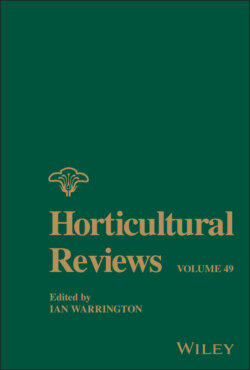Horticultural Reviews, Volume 49

Реклама. ООО «ЛитРес», ИНН: 7719571260.
Оглавление
Группа авторов. Horticultural Reviews, Volume 49
Table of Contents
List of Tables
List of Illustrations
Guide
Pages
Editorial Board, Volume 49
HORTICULTURAL REVIEWS. Volume 49
Contributors
Dedication: Dr. Christopher B. Watkins
1 Oakleaf Hydrangea (Hydrangeaquercifolia Bartr.): Horticulture, Genetics, Breeding, and Conservation
ABSTRACT
I. INTRODUCTION
II. HISTORY AND TAXONOMY OF HYDRANGEA
III. NATURAL DISTRIBUTIONS OF HYDRANGEA SPECIES
IV. HISTORY AND DISTRIBUTION OF OAKLEAF HYDRANGEA
V. MORPHOLOGY OF OAKLEAF HYDRANGEA
VI. BIOTIC AND ABIOTIC CONSIDERATIONS
VII. GENETICS AND BREEDING. A. Ploidy and Genome Size
B. Pollination Biology
C. Breeding for Disease Tolerance/Resistance
D. Breeding for Compactness
E. Breeding for Cold Hardiness
F. Breeding for Floral Characteristics
G. Germplasm Resources
H. Molecular Resources for Breeding
I. Genetic Variation in Hydrangea
VIII. CONSERVATION
IX. PROPAGATION
X. FUTURE PROSPECTS
LITERATURE CITED
2 Biostimulants in Agricultural and Horticultural Production
ABSTRACT
I. INTRODUCTION
A. Plant Biostimulants: Definitions and Key Concepts
II. MICROBIAL INOCULANTS. A. Introduction: The Phytomicrobiome
1. Biofilm Formation in the Phyllosphere
B. Definitions and Key Concepts
C. Mechanisms and Modes of Action
1. Phytostimulation
2. Biofertilization
3. Biocontrol
D. Crop Responses to Microbial Inoculants. 1. Plant Growth Promotion
2. Increased Tolerance to Abiotic Stress
3. Biocontrol and Disease Resistance
E. Microbial Consortia
F. Challenges for Developing Effective Microbial Inoculants
G. Summary – Microbial Inoculants
III. HUMIC SUBSTANCES: HUMIC AND FULVIC ACIDS. A. Definitions and Key Concepts
B. Mechanisms and Modes of Action
1. Plant Growth Promotion
2. Increased Tolerance to Abiotic Stress
C. Summary – Humic Substances
IV. SEAWEED EXTRACTS. A. Definitions and Key Concepts
B. Modes of Action
C. Crop Responses to Seaweed Extracts. 1. Plant Growth Promotion
2. Increased Tolerance to Abiotic Stress
3. Enhanced Disease Resistance
D. Summary and Further Research‐Seaweed Extracts
V. FUTURE DIRECTION: SYNERGISM OF BIOSTIMULANTS IN COMBINATION
VI. FUTURE DIRECTION: BIOSTIMULANTS IN SOILLESS PRODUCTION SYSTEMS
VII. CONCLUSIONS
LITERATURE CITED
3 Postharvest Physiological Disorders of Banana Fruit: Finger Drop, Senescent Spotting, and Chilling Injury
ABSTRACT
I. INTRODUCTION
II. FRUIT STRUCTURE AND MORPHOLOGY
III. POSTHARVEST PHYSIOLOGICAL DISORDERS
IV. FINGER DROP
A. Symptom Development
B. Causal Factors
1. Clonal Differences
2. Relative Humidity (RH)
3. Temperature
4. Ethylene
5. Other Factors
C. Biochemical Processes Involved
D. Management Practices for Control of the Disorder
1. Clonal Selection
2. Environment
3. Chemicals
V. SENESCENT SPOTTING
A. Symptom Development
B. Causal Factors
1. Clonal Differences
2. Maturity
3. Temperature
4. Atmospheres
C. Biochemical Processes Involved
D. Management Practices for Control of the Disorder
1. Atmospheres
2. Temperature
3. Heat Treatment
4. Chemicals
5. Ethylene and Its Inhibitors
VI. CHILLING INJURY
A. Symptom Development
B. Causal Factors
1. Clonal Differences
2. Maturity
3. Temperature
4. Atmospheres
5. Ethylene
C. Biochemical Processes Involved
D. Management Practices for Control of the Disorder
1. Clonal Selection
2. Genetic Modification
3. Temperature Manipulation
4. Atmospheres
5. Heat Treatment
6. Chemicals
7. Ethylene Inhibitor (1‐MCP)
VII. CONCLUSIONS
ACKNOWLEDGMENTS
LITERATURE CITED
4 Mechanical Harvesting of Selected Temperate and Tropical Fruit and Nut Trees
ABSTRACT
I. INTRODUCTION
II. MECHANICAL HARVESTING METHODS
A. Human Harvesting Aids
B. Mechanical Harvesters
1. Limb Shakers
2. Air Blasts
3. Trunk Shakers
4. Canopy Shakers
5. Catching Frames
III. COMMERCIAL HARVESTERS FOR NUT AND FRUIT TREES. A. Almond
B. Apple
C. Apricot
D. Blueberry
E. Cherry
F. Coffee
G. Fig
H. Grape
I. Jatropha
J. Mango
K. Peach
L. Pistachio
M. Plum
N. Stone Pine
IV. SMART HARVESTING
A. Machine Vision
B. Sensors
C. Bruise Detection
D. Efficiency and Yield Estimation
V. FACTORS AFFECTING MECHANICAL HARVESTING
A. Damping Properties of Trees
B. Injuries
C. Bruising
D. Clamping Height
E. Debris and Trash Issues
F. Orchard Design
G. Abscission Chemicals
VI. CHALLENGES, FUTURE OUTLOOK, AND RECOMMENDATIONS
A. Cost
B. Operator Dependency
LITERATURE CITED
5 Apple Fruitlet Abscission Mechanisms
ABSTRACT
I. INTRODUCTION
A. Apple as a Model Species for Fruit Abscission
B. The Abscission Process
II. CORRELATIVELY DRIVEN ABSCISSION
III. CARBOHYDRATE STRESS
IV. CONTRASTS BETWEEN CDA AND CS
V. MORPHOLOGICAL AND EXOGENOUS FACTORSAFFECTING FRUITLET ABSCISSION. A. King Dominance
B. Chemical Thinner Mode of Action
1. Synthetic Auxins
2. Benzyladenine
3. Ethylene Inducers
4. Photosynthetic Inhibitors
5. Carbaryl
6. Abscisic Acid
7. Summary of Chemical Thinners
VI. CONCLUSIONS AND FUTURE DIRECTIONS
LITERATURE CITED
Subject Index
Cumulative Subject Index
Cumulative Contributor Index
WILEY END USER LICENSE AGREEMENT
Отрывок из книги
Horticultural Reviews is sponsored by:
.....
James E. Larson, Department of Horticulture. North Carolina State University, Mountain Horticultural Crops Research and Extension Center, Mills River, NC 28759, USA
Anish Malladi, Department of Horticulture, University of Georgia, 1111 Miller Plant Sciences, Athens, GA 30602, USA
.....